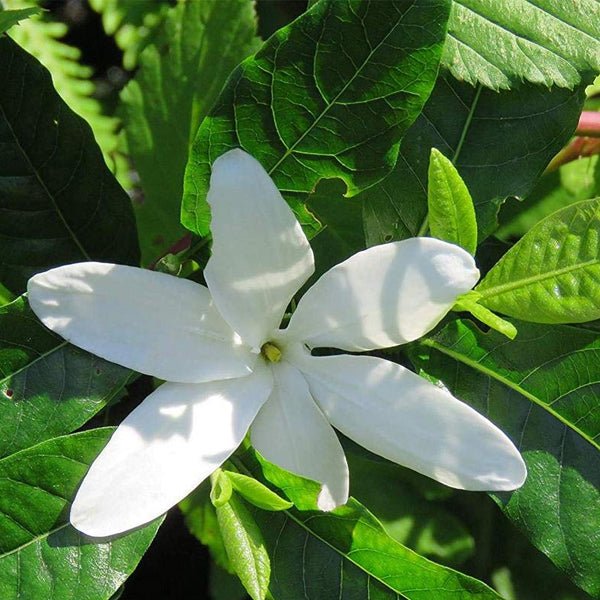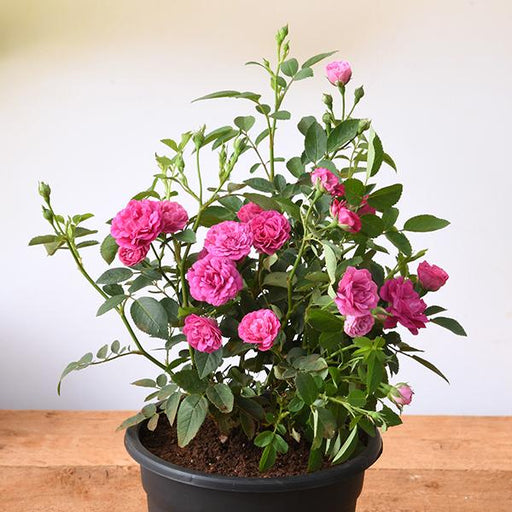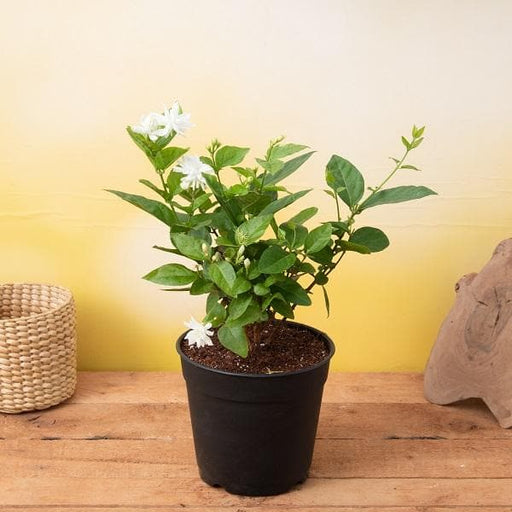
Hing, Asafoetida - Plant
(MRP Inclusive of all taxes)
- Shipping ₹79 for entire order
- Dispatch in 7 days
- Country of origin: India

(MRP Inclusive of all taxes)
 Save 29%
Save 29%
Air Purifier Money Plant with Pot The Air Purifier Money Plant, also known as Pothos or Epipremnum aureum, is a stunning indoor plant that...
View full details
 Save up to 15%
Save up to 15%
Peace Lily, Spathiphyllum - Plant The Peace Lily, scientifically known as Spathiphyllum, is a stunning houseplant celebrated for its elegant white...
View full details
 Save 25%
Save 25%
Jasminum sambac, Mogra, Arabian Jasmine - Plant Jasminum sambac, commonly known as Mogra or Arabian Jasmine, is a fragrant flowering plant...
View full details
 Save 18%
Save 18%
Combo Constituents Includes the Parijat Tree (Night-Flowering Jasmine), a culturally significant plant with fragrant flowers. Description The Pari...
View full details
 Save 25%
Save 25%
Miniature Rose, Button Rose (Any Color) - Plant The Miniature Rose, also known as the Button Rose, is a charming and compact flowering plant that ...
View full details Save 25%
Save 25%
Damascus Rose, Scented Rose (Any Color) - Plant The Damascus Rose, also known as Rosa damascena, is a timeless symbol of beauty and romanc...
View full details
 Save 17%
Save 17%
Beautiful Fragrant Mogra, Arabian Jasmine Plant with Pot The Beautiful Fragrant Mogra, also known as Arabian Jasmine (Jasminum sambac), is...
View full details Save 15%
Save 15%
Pack of Vermicompost and Neem Cake for House Plants Transform your indoor garden with our premium Pack of Vermicompost and Neem Cake, spec...
View full details
Pack of Plant Growth and Flower Boosters Unlock the full potential of your garden with our Pack of Plant Growth and Flower Boosters! This ...
View full details Save 38%
Save 38%
Combo of Jeevamrut and Neem Raksha for Easy Growth and Protection of Houseplants Transform your indoor garden with our exclusive combo of ...
View full details Save 22%
Save 22%
Plant Nutrients Kit (Pack of 16) for a Healthy Garden Transform your garden into a lush paradise with our Plant Nutrients Kit, featuring 1...
View full details Save 16%
Save 16%
Combo of Top Plant Fertilizers Elevate your gardening game with our exclusive Combo of Top Plant Fertilizers, featuring two bags of premiu...
View full details Save 24%
Save 24%
Pack of 4 Additives to Make Soil Healthy and Nutrient Rich Transform your garden into a thriving ecosystem with our Pack of 4 Additives de...
View full details Save 30%
Save 30%
Transform your gardening experience with our premium Combo of Perlite and Vermiculite. This unique blend is designed to enhance soil aeration and ...
View full details Save 27%
Save 27%
Combo of 2 Vermicompost and Cocopeat - Enrich Your Soil Naturally! Transform your garden into a thriving ecosystem with our Combo of 2 Ver...
View full details
 Save 35%
Save 35%
Best 6 Plants for Perfect Indoor Garden Transform your living space into a lush oasis with our curated collection of the Best 6 Plants for a...
View full details
 Save up to 50%
Save up to 50%
Mini Succulent Garden Pack Transform your space with our Mini Succulent Garden Pack, featuring a delightful collection of 4 any variety beautiful s...
View full details
 Save 30%
Save 30%
5 Best Fragrant Plants Transform your garden or indoor space into a fragrant paradise with our curated selection of the 5 Best Fragrant Plants. Th...
View full details
 Save 24%
Save 24%
Set of 2 Bonsai Looking Grafted Adeniums Transform your indoor or outdoor space with our exquisite Set of 2 Bonsai Looking Grafted Adenium...
View full details Save 45%
Save 45%
Top 4 Die Hard Succulents Pack Transform your indoor or outdoor space with our Top 4 Die Hard Succulents Pack, featuring a curated selecti...
View full details
 Save 30%
Save 30%
5 Best Indoor Plants Pack Transform your living space into a lush oasis with our '5 Best Indoor Plants Pack.' This carefully curated collection fe...
View full details
 Save 25%
Save 25%
Set of 4 Evergreen Air Purifier Plant Pack Transform your indoor space into a lush, green oasis with our Set of 4 Evergreen Air Purifier Pla...
View full details| SrNo | Item Name |
|---|---|
| 1 | Hing, Asafoetida - Plant |
Hing, scientifically known as Ferula assa-foetida, is a perennial herb native to the mountainous regions of Iran and Afghanistan. Renowned for its pungent aroma and unique flavor, this plant is a staple in Indian cuisine and traditional medicine. The resin extracted from its roots is used as a spice, often referred to as "devil's dung" due to its strong smell. Rich in antioxidants and anti-inflammatory properties, Hing is not only a culinary delight but also a health booster.
What makes Hing special is its versatility. It enhances the flavor of various dishes while providing numerous health benefits, including aiding digestion and reducing bloating. Its unique flavor profile makes it an essential ingredient in vegetarian and vegan cooking, offering a savory umami taste that mimics the flavor of garlic and onion.
One of the special features of Hing is its ability to thrive in arid conditions, making it an environmentally friendly choice for sustainable gardening. This hardy plant requires minimal water and can grow in poor soil, contributing to soil health and biodiversity.
Hing plants contribute positively to the environment by improving soil health and requiring minimal water resources. Their ability to thrive in arid conditions makes them an excellent choice for sustainable agriculture, promoting biodiversity and resilience in ecosystems.
Ah, the magical world of hing! This pungent spice, also known as asafoetida, is not just a culinary delight but a health powerhouse. Packed with anti-inflammatory properties, hing can help soothe digestive woes and even combat respiratory issues. It’s like a superhero in your spice rack, ready to save the day when your tummy is grumbling or your sinuses are acting up. Plus, it adds a unique flavor to dishes that will have your taste buds dancing. Who knew something that smells like a skunk could be so beneficial?
If you think hing is just a one-trick pony, think again! This versatile spice can elevate a variety of dishes, from lentil soups to vegetable stir-fries. A pinch of hing can transform your meal from bland to grand, adding a savory depth that’s hard to resist. It’s the secret ingredient that chefs whisper about, and once you start using it, you’ll wonder how you ever cooked without it. Just remember, a little goes a long way—too much, and you might clear the room faster than a fire alarm!
Growing your own hing plant is like embarking on a botanical adventure! This hardy herb thrives in well-drained soil and plenty of sunlight, making it the perfect companion for those with a green thumb. Just imagine the satisfaction of plucking fresh hing from your garden, ready to spice up your culinary creations. But beware, this plant can be a bit temperamental—too much water, and it might sulk; too little, and it’ll throw a tantrum. Treat it right, and it’ll reward you with a bounty of aromatic goodness.
In the ancient world of Ayurveda, hing is revered as a digestive aid and a remedy for various ailments. It’s like the wise old sage of spices, offering wisdom and healing properties to those who seek it. From alleviating gas to promoting overall gut health, hing has been a trusted ally for centuries. So, if you’re feeling a bit off, consider channeling your inner Ayurvedic guru and incorporating this magical spice into your routine. Your body will thank you, and you might just impress your friends with your newfound knowledge!
hing or garlic? While garlic has its own loyal fanbase, hing brings a unique flavor profile that can’t be ignored. It’s like the mysterious cousin at a family reunion—unexpected but unforgettable. Both have their merits, but hing offers a pungent kick without the lingering breath issues. So, if you’re looking to spice things up without the garlic aftermath, hing is your go-to. Plus, it’s a great conversation starter at dinner parties—“Oh, you’ve never tried hing? Let me enlighten you!”
In the realm of traditional medicine, hing is like the Swiss Army knife of remedies. From treating indigestion to alleviating menstrual discomfort, this spice has been used for centuries to tackle a variety of health issues. It’s a natural solution that has stood the test of time, proving that sometimes, the best medicine comes from nature. So, the next time you’re feeling under the weather, consider reaching for hing instead of that over-the-counter concoction. Your body will appreciate the holistic approach!
If you thought hing was just for cooking, think again! Hing essential oil is the aromatic cousin that brings all the benefits of the spice in a concentrated form. Known for its anti-inflammatory and antimicrobial properties, this oil can be used in aromatherapy or diluted for topical application. Just a few drops can help clear your sinuses or soothe sore muscles. It’s like having a mini spa experience right in your home, all thanks to the power of hing. Who knew self-care could smell so good?
Vegans, rejoice! Hing is your secret weapon for adding depth and umami to plant-based dishes. It’s the perfect substitute for those who miss the savory notes of meat in their meals. A dash of hing can turn a simple vegetable stir-fry into a flavor explosion that even non-vegans will love. So, whether you’re whipping up a hearty lentil stew or a zesty chickpea salad, don’t forget to sprinkle in some hing. Your taste buds will thank you, and your friends will be none the wiser!
Storing hing is an art form in itself. This spice is sensitive to moisture and light, so it’s best kept in an airtight container in a cool, dark place. Treat it like the diva it is—no exposure to the elements! If you want to keep its pungent aroma intact, avoid storing it near strong-smelling spices. After all, we wouldn’t want our beloved hing to start mingling with the cumin, would we? Follow these tips, and you’ll have fresh hing ready to elevate your dishes for months to come.
When it comes to gut health, hing is like the friendly neighbor who always brings over homemade cookies. It’s known for its ability to aid digestion and reduce bloating, making it a must-have for anyone who enjoys a good meal. Incorporating hing into your diet can help keep your digestive system running smoothly, so you can enjoy your favorite foods without the uncomfortable aftermath. So, next time you’re indulging in a feast, sprinkle some hing on your plate and let the magic happen!
In Indian cuisine, hing is the unsung hero that adds a distinctive flavor to countless dishes. From dal to curries, this spice is a staple that brings warmth and richness to the table. It’s like the secret sauce that ties everything together, making every bite a delightful experience. If you’ve never tried hing in your cooking, you’re missing out on a culinary adventure that will transport your taste buds straight to India. So, grab your apron and get ready to spice things up with this aromatic gem!
Hing, or Asafoetida, is the culinary superstar of the spice world, derived from the resin of the Ferula plant. It’s like garlic’s quirky cousin, adding a pungent kick to dishes while also being a digestive superhero. Who knew a plant could be both a flavor enhancer and a tummy soother
Hing is the secret ingredient that transforms ordinary dishes into extraordinary ones! Just a pinch can elevate lentils, curries, and even soups. It’s often used in Indian cuisine, where it’s sautéed in oil to unleash its unique flavor. Think of it as the spice that brings the party to your palate!
Absolutely! Hing is not just a pretty face in the spice rack; it’s packed with health benefits. It aids digestion, reduces bloating, and can even help with respiratory issues. So, while you’re enjoying that delicious curry, you’re also giving your body a little TLC. Who knew indulgence could be so healthy
Hing is easier to find than your lost socks! You can snag it at Indian grocery stores, health food shops, or online retailers. Just make sure to get the good stuff—look for high-quality, pure Asafoetida to ensure your dishes taste divine. Your taste buds will thank you!
Hing is a diva that likes to be pampered! Store it in an airtight container, away from light and moisture, to keep its pungent charm intact. A cool, dark cupboard is its happy place. Treat it right, and it’ll reward you with flavor that’s nothing short of magical!
Absolutely! Hing is a vegan’s best friend, adding depth and flavor without any animal products. It’s perfect for enhancing vegetable dishes, soups, and even vegan cheeses. So, whether you’re a full-time vegan or just dabbling, Hing will make your meals sing with flavor!
Hing has a flavor profile that’s hard to pin down—think garlic meets onion with a hint of earthiness. It’s bold, pungent, and can be a bit overwhelming if overused. Just a pinch is all you need to add a savory depth to your dishes. It’s a flavor adventure waiting to happen!
Yes, Hing is generally safe for most people, but moderation is key! Some may experience digestive discomfort if they overindulge. Pregnant women should consult their doctor before diving into the Hing pool. So, enjoy it wisely, and let the flavor fiesta begin without any tummy troubles!
If you’re in a pinch and don’t have Hing, garlic powder or onion powder can step in as substitutes. They won’t replicate the exact flavor, but they’ll add a savory touch. Just remember, Hing is one-of-a-kind, so it’s best to keep it on hand for those culinary masterpieces!
Hing comes in various forms: powdered, granulated, and even in resin form. The powdered version is the most common and easiest to use. Each form has its own charm, but the powdered variety is like the trusty sidekick in your spice cabinet—always ready to save the day!
Yes, Hing has a long history in traditional medicine, especially in Ayurveda. It’s believed to have anti-inflammatory and antimicrobial properties. Used in small doses, it can help with digestion and respiratory issues. So, while you’re cooking up a storm, you’re also channeling ancient wisdom—talk about a two-for-one deal!